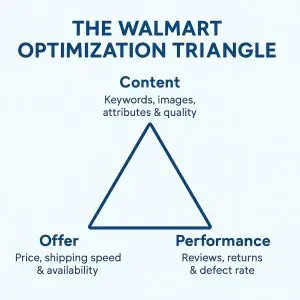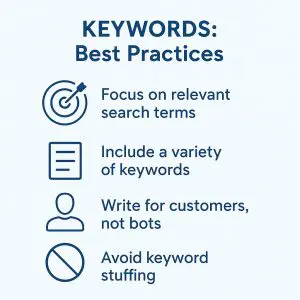Walmart SEO – Relevance Algorithm
Walmart Relevance Algorithm: The Complete Guide to Ranking on Walmart
This guide is written so a curious middle-schooler can follow it—and detailed enough that senior e-commerce managers will still learn a ton.
- What is the Walmart Relevance Algorithm?
- Why it matters (and how it’s different from Amazon)
- The Optimization Triangle: Content · Offer · Performance
- Content SEO: keywords, titles, bullets, attributes & images
- Offer strength: price, shipping speed, availability & Buy Box
- Performance: reviews, returns & seller metrics
- WFS vs Self-Fulfillment: impact on ranking
- Pricing strategy that helps SEO (without killing margins)
- How Walmart ads interact with organic ranking
- Testing & monitoring: KPIs, tools & split tests
- Myths, mistakes & how to fix them
- Copy-and-paste Walmart SEO checklist
- FAQ: Walmart Relevance Algorithm
What is the Walmart Relevance Algorithm?
When a shopper types “wireless headphones” into Walmart’s search bar, the site must decide which products to show first. That decision is made by the Walmart Relevance Algorithm—a ranking system (often referred to internally as “Polaris”) that scores each listing for a query and orders results from most helpful to least.
Think of it like a teacher sorting homework from “best answer” to “okay answer.” The algorithm tries to show the most relevant and trustworthy products first, based on three big ideas: how well your content matches the search, how strong your offer is (price + shipping + stock), and how happy customers are with you and your product.
Why it matters (and how it’s different from Amazon)
- Visibility = sales. Most clicks go to page-one results. If you’re not ranking, you’re invisible.
- Lower ad costs long-term. Better organic ranking means you don’t have to “rent” traffic forever with ads.
- Different than Amazon. Amazon’s algorithm is famously obsessed with sales velocity. Walmart cares a lot about that too, but it leans more into customer experience: clear content, competitive pricing, fast delivery, reliable stock, and good reviews.
The Optimization Triangle: Content · Offer · Performance
Walmart’s ranking logic can be simplified into a triangle of influence:

1) Content
Keywords in titles, bullets, long descriptions, and attributes. High-quality images & video. Proper category & rich specs.
2) Offer
Competitive total price (item + shipping), fast delivery (TwoDay/NextDay), consistent in-stock, Buy Box eligibility.
3) Performance
Star ratings, review volume, return rate, on-time ship rate, cancellation rate, Order Defect Rate, and responsiveness.
Content SEO: keywords, titles, bullets, attributes & images
Keyword research the Walmart way
Start with the exact phrases shoppers use. On Walmart, exact-match keywords in your title and attributes tend to carry strong weight. Build a list of:
Primary Keywords
Long-tails
Synonyms
Use-case terms
Title structure that ranks and reads well
- Format: Brand + Product Type + Key Feature(s) + Size/Qty/Color
- Length: aim ~50–75 characters (concise and scannable).
- Front-load your primary keyword; avoid ALL CAPS and fluff (“Best!! Wow!!!”).
- Example: Acme Wireless Bluetooth Earbuds with Charging Case – Black
Bullets (Key Features) that answer “why buy?”
- Use 5–10 bullets; lead with benefits, then features.
- Sprinkle secondary keywords naturally.
- Answer common questions (battery life, material, compatibility, size).
Long description that converts
Write 150–400+ words in short paragraphs. Explain what the product is, who it’s for, how it’s used, and why it’s better. Use friendly language a 12-year-old can follow. Keep it unique for Walmart—don’t paste Amazon copy.
Attributes & category precision
Fill every relevant spec (brand, material, size, age group, etc.). Accurate category + complete attributes help you appear in filtered searches and category browse results.
Images & rich media
- Upload 6–9 images (min 1000×1000). Main image on white; include lifestyle and detail shots.
- Add one clean infographic image highlighting 4–6 benefits.
- Include a short demo video if possible (30–60s). Visuals lift conversion, which lifts rank.

Offer strength: price, shipping speed, availability & Buy Box
Price for parity and value
- Walmart compares total price (item + shipping). Stay competitive, not necessarily the cheapest.
- Avoid big cross-channel price gaps; large differences can reduce visibility.
- Use promotions (strikethroughs, bundles) to spike conversion without permanent margin loss.
Ship fast—consistently
- TwoDay or NextDay tags meaningfully improve click-through and conversion.
- If self-fulfilling, only promise speeds you can hit every time.
Stay in stock
Frequent stockouts signal risk. Use demand forecasting and reorder points to keep your bestsellers live.
Buy Box basics
If multiple sellers share a listing, only the Buy Box owner gets the main sale. Price, shipping speed, and performance metrics drive eligibility. Win the box first—then everything else (SEO, ads) moves the needle.
Performance: reviews, returns & seller metrics
- Ratings & review volume: Products with steady, recent 4–5★ reviews are safer bets for the algorithm and shoppers.
- Return rate: High returns hint at mismatched expectations—improve images, sizing charts, and descriptions.
- Order Defect Rate (ODR): Keep cancellations, late shipments, and service issues low; monitor your scorecard weekly.
- Pro Seller Badge: Meeting high standards boosts trust and can lift click-through and conversion.
WFS vs Self-Fulfillment: impact on ranking

Why WFS helps
- Automatic TwoDay badge → higher CTR & conversion.
- Walmart-managed logistics reduce late shipments and cancellations.
- Stronger Buy Box eligibility; enables Sponsored Products ads.
When to self-fulfill
- Oversized/overspecial items or categories not supported by WFS.
- You can reliably deliver 2-day regionally/nationally with SLAs met.
Pricing strategy that helps SEO (without killing margins)
- Know your floor: Calculate landed cost + desired margin so you never reprice below profit.
- Use smart repricing: React to market shifts within bounds; avoid wild swings.
- Bundle for value: Differentiate to reduce direct price comparisons.
- Time promos: Use limited-time deals to build sales velocity and review flow.
How Walmart ads interact with organic ranking
Sponsored Products don’t directly “buy” organic rank, but the sales they generate increase velocity, review volume, and behavioral signals—which feed organic ranking. Smart approach:
- Launch with small daily budgets on exact/phrase keywords that mirror your title and bullets.
- Harvest converting search terms from ad reports and weave them into content and attributes.
- Balance spend: taper bids as organic rank on target terms improves to protect margin.
Testing & monitoring: KPIs, tools & split tests
KPIs to watch weekly
- Search impressions (are you showing up?)
- CTR (title & main image pulling clicks?)
- Conversion rate (page persuading buyers?)
- Keyword rankings (manual spot checks + tool tracking)
- Buy Box win rate (on shared listings)
- ODR / on-time ship % / cancel % (seller scorecard)
Practical split tests
- Title v1 vs v2: keep meaning identical, adjust order/clarity/keyword placement.
- Main image: flat lay vs lifestyle; add/remove subtle context props.
- Bullets: benefit-first vs spec-first.
- Price: ±3–5% to find elasticity without harming the Buy Box.
Simple cadence
Weekly: metrics check → one controlled change → observe 7–14 days. Monthly: larger refresh (images/video) for top SKUs. Document everything so you know what moved the needle.
Myths, mistakes & how to fix them
- Myth: “Just copy your Amazon listing.” Fix: Shorter, clearer Walmart titles; unique content; Walmart-specific attributes.
- Mistake: Keyword stuffing. Fix: Exact matches matter—but keep language natural and helpful.
- Mistake: One photo only. Fix: 6–9 images + 1 infographic + short video.
- Mistake: Overpromising shipping. Fix: Promise only what you can hit every time.
- Mistake: Ignoring reviews. Fix: Clarify sizing/specs; improve packaging; encourage feedback within policy.
- Myth: “Lowest price or nothing.” Fix: Be competitive; win on speed, quality, and clarity too.
Copy-and-paste Walmart SEO checklist (print-worthy)
- ✅ Title: Brand + Product + Key feature + Size/Qty/Color; ~50–75 chars; primary keyword near front.
- ✅ Bullets: 5–10 clear, benefit-led points; include secondary keywords naturally.
- ✅ Long description: 150–400+ words; friendly, skimmable; unique to Walmart.
- ✅ Attributes: Fill all relevant specs; correct category/subcategory.
- ✅ Images: 6–9 high-res; lifestyle + detail; 1 clean infographic; add a 30–60s video if possible.
- ✅ Price: Competitive total price (item + shipping); avoid cross-channel gaps; plan promos.
- ✅ Shipping: TwoDay/NextDay if possible; otherwise, honest SLAs you can always meet.
- ✅ Stock: Forecast, set reorder points; avoid stockouts on top SKUs.
- ✅ Buy Box: Monitor win rate on shared listings; adjust price/ship to win.
- ✅ Performance: Watch ODR, on-time %, cancels, returns; pursue Pro Seller Badge.
- ✅ Reviews: Encourage within policy; fix recurring complaints.
- ✅ Ads: Start small; harvest converting terms; fold into content.
- ✅ Track: Impressions, CTR, conversion, ranks, Buy Box—weekly; test one change at a time.
Need hands-on help implementing this checklist? Talk to Prolific Zone about Walmart SEO & WFS rollout.
FAQ: Walmart Relevance Algorithm
Does advertising directly boost organic rank?
Not directly. Ads create sales and behavioral signals that do help organic ranking. Think of ads as an accelerator for a well-optimized listing.
Is price the #1 factor?
It’s critical, but not alone. Walmart considers Content + Offer + Performance together. A slightly higher-priced item with faster shipping, better reviews, and clearer content can outrank a cheaper one.
How important is exact-match keywording?
Very. Use shopper phrasing in your title, bullets, description, and attributes—naturally and clearly.
Do videos matter?
Yes. Videos improve understanding and trust, lifting conversion—one of the strongest signals the algorithm responds to.
What hurts ranking the fastest?
Stockouts, high cancellations, slow shipping, poor ratings, and unclear content. Fix operational issues as urgently as you fix keywords.
Can I reuse my Amazon copy?
Use it as a starting point, but tailor it for Walmart: shorter titles, Walmart attributes, Walmart’s tone, and policy compliance.
